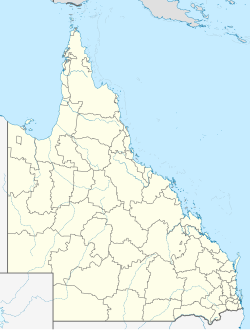History
In 1880, gold was found in Woolgar, initiating a gold rush. [14] [15] [16] The gold rush followed the common pattern of individual miners initially engaging in panning for gold, followed by digging to find shallow reefs, and then companies raising capital for the equipment to search for deep reefs. [17]
On 14 September 1881, Sub-inspector Henry Pollock Kaye of the Native Mounted Police, was responding to complaints from at the Woolgar gold fields townspeople of the First Nations persons stealing and other offences. [18] Together with other police and a native trooper, he mustered the indigenous persons to remove them from the area. It was indicated there may have been up to 800 indigenous persons in the area, although only some thirty to forty were to be removed. Within fifteen minutes of Sub-inspector Nichols leaving to get other officers, Kaye was fatally speared by the persons. [19] A retaliatory massacre is believed to have occurred against the indigenous persons. [20]
Woolgar Upper Provisional School opened on 19 June 1901 and Woolgar Lower Provisional School opened on 24 June 1901, to work together as part-time schools (meaning a single teacher was shared between them). They closed in October 1903 but reopened in April 1904. Woolgar Lower Provisional School closed on 11 October 1906 while Woolgar Upper Provisional School continued as a full-time school and closed circa 1912. [21]
In 2000, the Woolgar Valley Aboriginal Corporation became the lessee of the 130,000-hectare (320,000-acre) Middle Park pastoral station, '"to provide opportunities for the traditional owners of that area, the Woolgar people, who mostly live in Yarrabah, Hopevale and Townsville". [22] [23]
This page is based on this
Wikipedia article Text is available under the
CC BY-SA 4.0 license; additional terms may apply.
Images, videos and audio are available under their respective licenses.

